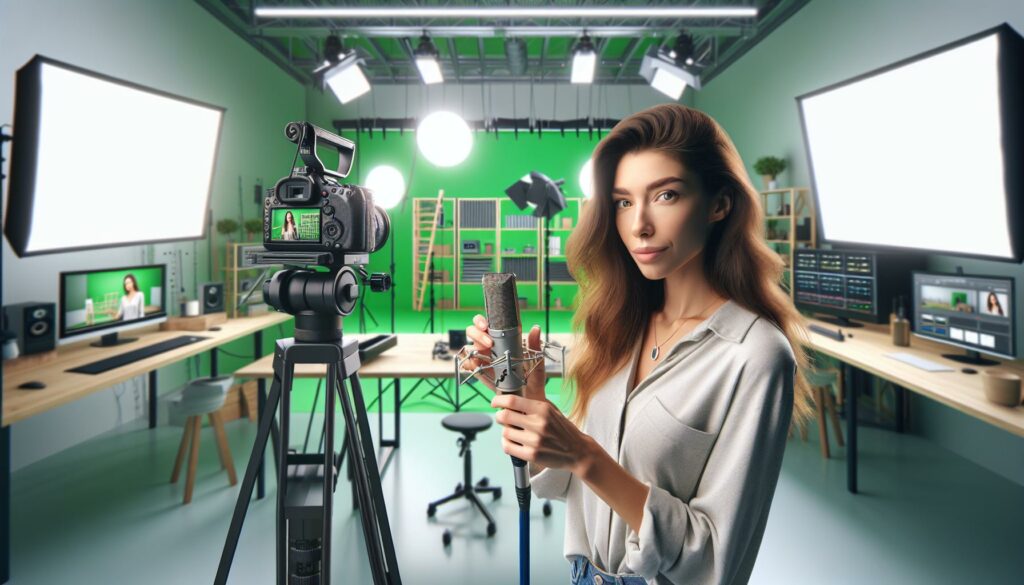”
As a content creator I’ve witnessed the incredible rise of content creation studios over the past decade. These dynamic spaces have transformed how we produce digital content combining cutting-edge technology with creative expertise to deliver professional-grade videos podcasts and social media content.
I’ll admit that when I first stepped into a content creation studio I was amazed by the endless possibilities. From green screens and professional lighting setups to high-end audio equipment and editing suites these facilities offer everything creators need under one roof. Whether you’re a seasoned influencer a business owner or just starting your content journey these studios provide the tools and environment to bring your vision to life.
Key Takeaways
- Content creation studios combine technology, equipment, and creative resources to produce professional-grade digital content across multiple formats like video, podcasting, and photography
- Professional studios offer cost-effective alternatives to DIY setups, saving up to 70% on equipment investments while providing access to high-end gear and maintenance
- Studios typically feature specialized configurations including video production areas (800-1,200 sq ft), podcast recording spaces with high STC ratings, and dedicated control rooms
- When choosing a studio, key factors include location (within 30-minute drive radius), accessibility features, and flexible booking options ranging from hourly ($75-150) to monthly rates
- Running a content studio requires strategic investment in production equipment ($7,000-17,000), space optimization ($38,000-68,000), and ongoing software/services ($3,000-7,300 annually)
Content Creation Studios
Content creation studios serve as professional spaces designed for producing high-quality digital media content. These specialized facilities combine technology, equipment, and creative resources in a controlled environment.
Types of Content Creation Studios
- Photography Studios – Equipped with backdrops, lighting grids and product photography setups
- Video Production Studios – Feature soundproofing, multiple camera angles and filming areas
- Podcast Recording Studios – Include acoustic treatment, mixing boards and broadcast-quality microphones
- Live Streaming Studios – Set up with streaming software, encoding equipment and multi-camera switching
- Virtual Production Studios – Incorporate LED walls, motion capture systems and real-time rendering
- Social Media Studios – Optimized for short-form vertical content with quick setup configurations
- Professional Lighting
- LED panel arrays
- Softboxes
- Ring lights
- Track lighting systems
- Audio Equipment
- XLR microphones
- Audio interfaces
- Acoustic panels
- Isolation booths
- Visual Technology
- 4K/8K cameras
- Green screens
- Teleprompters
- Monitor displays
- Production Tools
- Editing workstations
- Storage systems
- Live switching boards
- Camera stabilizers
- Studio Amenities
- Makeup/wardrobe areas
- Client lounges
- Equipment storage
- Climate control
Benefits of Using Professional Studios
Professional content creation studios provide distinct advantages that enhance content quality while streamlining the production process. Here’s a detailed look at the key benefits based on my experience working with various studio setups.
Cost-Effectiveness vs DIY Setups
Professional studios eliminate substantial upfront investment in equipment. A complete DIY setup requires $15,000-$30,000 for basic professional gear: cameras, lighting, audio equipment. Here’s a comparison of costs:
| Setup Type | Initial Cost | Monthly Operating Cost | Equipment Maintenance |
|---|---|---|---|
| DIY Studio | $15,000-$30,000 | $300-$500 | $1,000-$2,000/year |
| Professional Studio Rental | $0 | $500-$1,000 | $0 |
Professional studios spread equipment costs across multiple clients, making high-quality production accessible through hourly or daily rates. I’ve found that renting studio space for 2-3 projects monthly costs 70% less than maintaining a personal studio.
Access to High-End Equipment
Professional studios provide immediate access to premium production gear. I regularly utilize:
- Cinema-grade cameras: RED Digital Cinema cameras RED KOMODO 6K
- Professional lighting systems: ARRI SkyPanel S60-C LED lights
- Sound equipment: Neumann U87 microphones Focusrite interfaces
- Post-production tools: DaVinci Resolve workstations color grading panels
- Specialized gear: Motion control rigs automated slider systems robotic arms
The equipment selection rotates with industry standards, ensuring access to the latest technology without additional investment. Each piece undergoes regular maintenance calibration by certified technicians, guaranteeing optimal performance for every shoot.
Popular Content Creation Studio Setups
Content creation studios feature distinct configurations optimized for specific content types. Each setup incorporates specialized equipment layouts to maximize production efficiency.
Video Production Studios
Video production studios combine three essential zones for optimal content creation. The main shooting area features sound-dampening panels mounted on walls spaced 18 inches apart with a minimum ceiling height of 12 feet. The control room houses video switchers, audio mixers, monitors plus a dedicated editing bay equipped with 4K-capable workstations. The prep area includes makeup stations, wardrobe racks, prop storage solutions organized in labeled bins for quick access during shoots.
| Video Studio Component | Typical Specifications |
|---|---|
| Main Shooting Area | 800-1,200 sq ft |
| Ceiling Height | 12-15 feet |
| Sound Treatment | 18-inch spaced panels |
| Control Room Size | 200-300 sq ft |
| Prep Area | 300-400 sq ft |
Podcast Recording Spaces
Podcast studios utilize acoustic treatment with specialized configurations for clear audio capture. The recording booth features double-wall construction with a 6-inch air gap filled with mineral wool insulation achieving an STC rating of 55+. The control room contains an audio interface connected to multiple XLR microphones routed through a digital mixing console. A dedicated livestreaming station includes an HD camera feed plus real-time monitoring displays for remote guest connections.
| Podcast Studio Element | Technical Requirements |
|---|---|
| Room STC Rating | 55+ |
| Wall Construction | Double-wall + 6″” gap |
| Microphone Setup | 4-8 XLR inputs |
| Monitor Displays | 2-3 screens |
| Internet Speed | 100+ Mbps upload |
How to Choose the Right Studio
Selecting a content creation studio requires evaluating multiple factors to match production requirements with available resources. My experience working with various studios has revealed key selection criteria that optimize both quality and cost-effectiveness.
Location and Accessibility
The studio’s location impacts production efficiency through travel time, parking availability and equipment transport options. I recommend choosing a studio within a 30-minute drive radius when transporting props or equipment. Studios in commercial areas often provide loading docks, freight elevators and dedicated parking spaces. Additional accessibility features include:
- 24/7 building access with security systems
- Ground-floor entrance with wide doorways (minimum 36 inches)
- Elevators that accommodate equipment carts
- Loading zones for gear unloading
- Proximity to public transportation hubs
Booking and Pricing Options
Studio rates vary based on space size, equipment included and booking duration. I’ve found these common pricing structures:
| Booking Type | Duration | Typical Rate Range |
|---|---|---|
| Hourly | 2-4 hours | $75-150/hour |
| Half Day | 4-6 hours | $300-600 |
| Full Day | 8-12 hours | $500-1,200 |
| Monthly | 30 days | $2,000-5,000 |
Key booking considerations include:
- Peak vs. off-peak hour rates
- Equipment package inclusion
- Crew assistance availability
- Cancellation policies
- Insurance requirements
- Deposit amounts
- Setup/breakdown time allowances
The studio’s online booking system, payment methods accepted and response time to inquiries indicate their operational efficiency.
Running Your Own Content Studio
Operating a content creation studio requires strategic planning in equipment investment, space optimization and revenue management. My experience running a successful studio has taught me the importance of balancing operational costs with income potential.
Essential Investment Areas
Initial studio investments focus on three core categories that directly impact content quality:
- Production Equipment
- Professional cameras ($3,000-8,000 per unit)
- Lighting kits with modifiers ($2,500-5,000)
- Audio recording systems ($1,500-4,000)
- Post-production workstations ($2,000-6,000)
- Space Requirements
- Sound treatment ($30-50 per square foot)
- Climate control systems ($5,000-10,000)
- Backup power solutions ($2,000-5,000)
- Storage facilities ($1,000-3,000)
- Software & Services
- Editing software licenses ($500-1,000 annually)
- Project management tools ($200-500 annually)
- Insurance coverage ($2,000-5,000 annually)
- Website hosting ($300-800 annually)
- Space Rental
- Hourly rates ($75-150)
- Half-day packages ($300-600)
- Full-day bookings ($500-1,200)
- Monthly memberships ($1,000-3,000)
- Equipment Rentals
- Camera packages ($150-400 daily)
- Lighting setups ($100-300 daily)
- Audio equipment ($75-200 daily)
- Production accessories ($50-150 daily)
- Production Services
- Video production ($1,000-5,000 per project)
- Photography sessions ($300-1,000 per session)
- Audio recording ($100-300 per hour)
- Post-production editing ($75-150 per hour)
Integral to Content Creation
Content creation studios have revolutionized the way we produce digital content. From my experience I’ve seen how these professional spaces empower creators with top-tier equipment and specialized environments without the burden of hefty upfront investments.
I believe that as the digital content landscape continues to evolve these studios will become even more integral to content creation. Whether you’re a seasoned professional or just starting out investing in studio time can significantly elevate your content quality while keeping costs manageable.
The future of content creation is bright and these studios are leading the charge in making professional-grade production accessible to creators of all levels.
“



